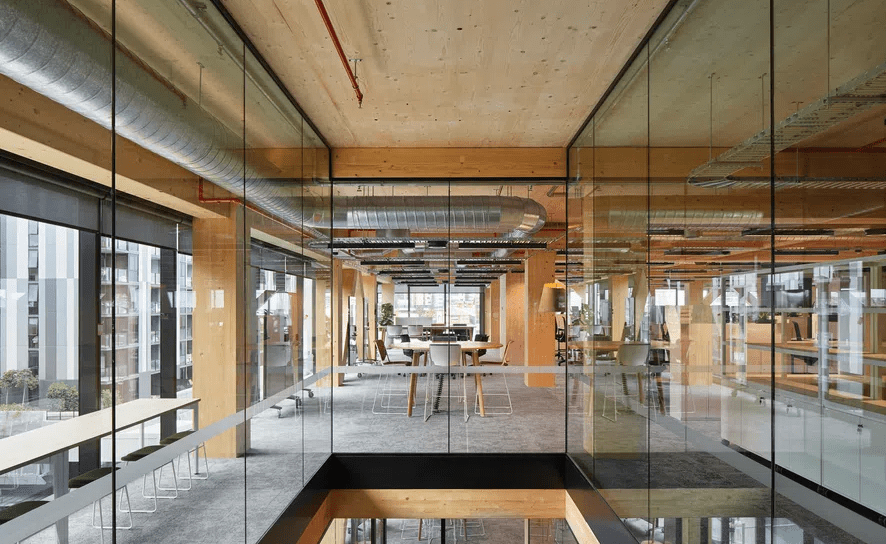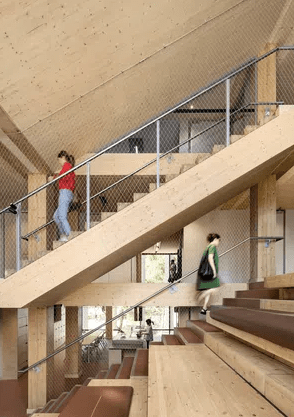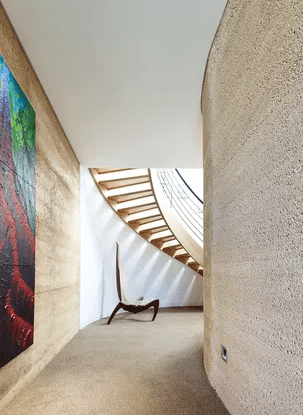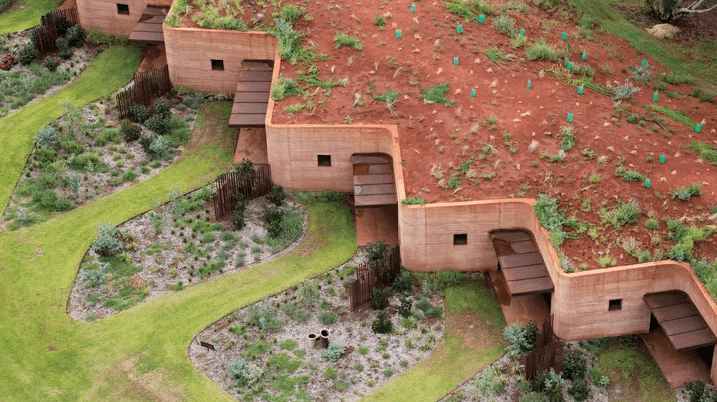In the shift to a circular economy, the construction industry will increasingly rely on the many sustainable qualities of bio-based materials. Bohemia Hookham describes these phenomena - some of which have been in use for thousands of years, others have been developed more recently, and still others we may see in the near future.

Bates Smart's 25 King is an innovative Brisbane workplace that connects the building's users to nature through pro-biological design
Architects are in a unique position to drive the global move toward a circular economy within the construction industry using bio-based materials.
For centuries, humans have used natural materials to build our built environment. Wood, bamboo, clay and straw are all readily available renewable natural materials. However, with the advent of the industrial age and the modernization of society and technology, renewable resources were replaced by other polluting materials such as cement and steel. Today, only about 3% of the world's building materials are bio-based; but that number is changing.
Biobased materials are derived from living organisms, such as plants, animals and fungi. Certain resources, such as wood and hemp, can be used in their raw state, while others, such as algae and mycelium, are often mixed with other materials to become useful composites.
Bio-based materials from plants can capture carbon from the atmosphere and convert it into biomass through photosynthesis. The use of bio-based materials to sequester carbon is a key step in moving the construction industry toward a circular economy.
Wood
The adoption of mass timber solutions, such as cross-laminated lumber (CLT), laminated veneer lumber (LVL) and glulam, has grown rapidly over the past few years and is expected to continue to grow at a CAGR of 13.6% from 2021 to 2028.
Large-area wood solutions offer a viable alternative to concrete, steel and aluminum. They can be renewable and sequester carbon, while connecting building users to the natural world through pro-biotic design elements. With prefabrication, installation time is significantly reduced and site risk is minimized compared to typical construction methods.
Bates Smart's 25 King, an office building in Brisbane, is by far the largest engineered timber commercial building in Australia. The superstructure is 45 meters high, over 9 stories, and consists of CLT (for walls, elevator shafts, escape stairs, roof and floors) and glulam (for structural beams and columns).
The project was built on a tunnel and was limited by weight; the use of timber superstructure made the building lighter compared to steel and concrete structures. Timber superstructures mean that early documentation and modularity are needed for efficient prefabrication. This has resulted in cleaner, quieter and safer construction sites with minimal waste and a reduction in the number of workers on site from 60 to 12. The entire floor was completed in 8 days and the entire building was finished in 15 months - thus reducing the time by 20% compared to steel and concrete.
The six-by-eight meter structural grid allows for efficient transportation of double-span CLT panels (12 meters in total length) in containers, while the grid spacing also allows for flexible and efficient floor panels to fit a variety of tenants. Exposed CLT planks for ceiling soffits eliminate the need for additional ceiling finishes, resulting in a higher floor-to-ceiling height that opens the floor to more natural light and provides a connection to nature through the exposed warm wood.

At Jackson Clements Burrows Architects' student accommodation at La Trobe University in Melbourne, over 90% of the load-bearing walls and columns are made of CLT and glulam
These demonstration projects showcase commercially viable alternatives to steel and concrete structures. But can forestry keep up with this growing demand? Timber prices in Australia have increased by 30% to 40% due to COVID related transport delays and high global demand for new home construction. So what other solutions are available?
Concrete
Hemp concrete is a biocomposite material consisting of hemp bark (the woody hard fibers of the cannabis plant) with lime, water and sand. Hemp itself grows extremely fast and is very effective at sequestering carbon through the cultivation process. The plant's strong fibers can also be processed into a variety of products, such as paper, textiles, bioplastics, food and biofuels, as well as building materials with excellent thermal and acoustic properties.
There are two main methods of building with cannabis concrete. The first uses forms to pour or spray the cannabis concrete mixture on site, while the second uses prefabricated blocks stacked on site like bricks. The compressive strength is much lower than concrete and is not suitable for load-bearing walls; instead, it is usually used in combination with a frame of another material, such as wood.
Hempcrete has low thermal conductivity, making it an excellent material for thermal insulation. It also has good sound insulation and is highly vapor permeable to help regulate internal humidity. According to Hempcrete Australia, in addition to these high performance properties, "it is estimated that each ton of lime based hempcrete absorbs and sequester 249 kg of CO2 over a 100 year life cycle."

The Hemp House, designed by Steffen Welsch Architects and completed in 2012, uses a combination of hempcrete, rammed earth and wood to create a multi-family home that features low energy consumption and a healthy bio-based interior.
rammed earth
Tulou is one of the oldest forms of construction, dating back to the Fertile Crescent of the Middle East in the ninth millennium B.C. and to China in the fifth millennium B.C. Some of the earthen construction methods include rammed earth, mud bricks, cornstalks, wattle and daub, and earth bags.
Rammed earth, also used for the interior walls of Hemp House, is an earthwork construction of gravel, sand, silt and clay, compressed into a formwork. Although cement is not required, it can be added to stabilize and add strength and durability, and when used it produces a compressive strength very similar to that of concrete. Cement used in rammed earth is typically 5 to 10 percent of the mixture, compared to concrete, which typically contains 10 to 15 percent cement. The negative impacts of cement are beyond the scope of this paper, but if the cement industry were a country, it would be the third largest emitter of CO2 in the world.
Cement-free rammed earth is a non-toxic, bio-based material that is completely biodegradable at the end of its life cycle.

Rammed earth also has a high thermal mass that delays heat flow through the walls, but depending on the local climate, it may still require additional insulation to address thermal comfort issues.
Rammed earth was used extensively in Luigi Rosselli Architects' Western Australian Wall project, which produced the longest (230m) rammed earth wall in Australia. The curving wall serves as the frontage for 12 short-term accommodation units buried in the sand dunes. The resulting design hides the building - from the back, it looks like a carefully manicured hill. Because it is located in the Pilbara - a large, dry and sparsely populated area of Western Australia with a harsh climate, red clay and large iron ore deposits - it was critical that the project use locally available materials.
The thermal properties of the rammed earth walls - iron-rich sand from local clay pans, together with cobbles and gravels extracted from the riverbed - helped create a comfortable living environment despite the harsh climate. The clay inside the wall has hygroscopic properties that create an evaporative cooling effect as the airflow moves along the wall, thus passively cooling the building.
Straw
Straw has been used extensively throughout human history and has made a comeback in recent years. Compressed straw building board products, such as Durra Panel or EcoCococon, are becoming more and more common. They are 100% recyclable and biodegradable; have strong thermal, acoustic and fire resistance properties; and can be used as a replacement for gypsum board. The panels are sold as a ready-made product, made from recycled wheat straw - an agricultural waste by-product that would otherwise be burned into the atmosphere. The manufacturing process itself combines heat and pressure to form the solid panels and uses a natural polymer derived from straw fibers as a binder.
Mycelium
Mycelium is the root-like structure of the mushroom growing fungus and consists of a network of thread-like branches called hyphae. As an important component of terrestrial and aquatic ecosystems, mycelium plays a huge role in the decomposition of organic matter. It has also been found to form large communication networks with other plants underground to facilitate the exchange of nutrients between forests and ensure the health of the entire ecosystem. Mycelium grows rapidly and can consume agricultural waste while sequestering the carbon from the biomass in which it grows. It has been tested in a variety of applications, from packaging to biodegradable bricks and insulation for buildings. Fashion brands such as Adidas, Stella McCartney and Lululemon have even released concept collections made from mycelium. While there are no off-the-shelf products for mycelium construction, research is underway - including NASA's exploration of using the material to build habitable homes on Mars.
Bio-based materials offer opportunities to reduce the implicit carbon footprint, improve energy efficiency through thermal performance, reduce construction waste, and promote a circular economy. In practice, the use of bio-based materials for design and construction has already begun. It is the responsibility of architects to challenge the construction industry in this area to promote the wider use of bio-based building materials.

